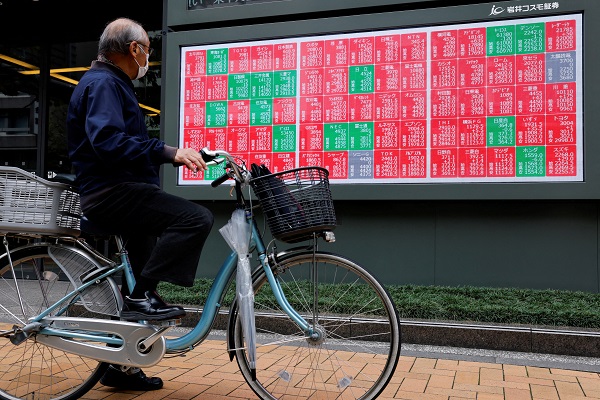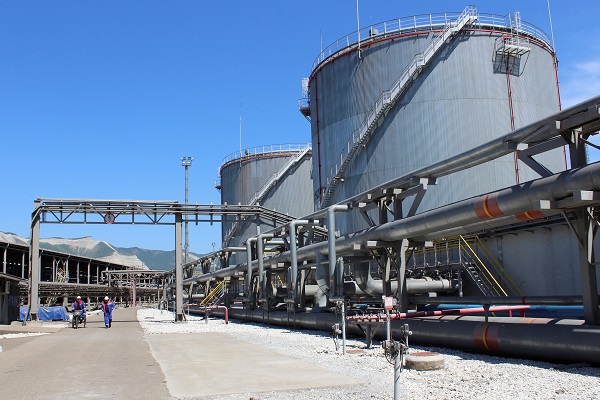Gold trading range for the day is 63960-65580 - Kedia Advisory

Gold
Gold experienced a notable uptick, closing up by 0.59% at 64845, fueled by growing expectations of the Federal Reserve's potential interest rate cut in June. Investors eagerly awaited Chair Jerome Powell's speech and key jobs data for further insights. Fed's Raphael Bostic's comments indicating the likelihood of two quarter-point rate cuts by year-end added momentum to gold prices. The focus now shifts to Powell's two-day congressional testimony, with investors seeking cues on the central bank's stance on rate-cut timings. The prospect of a Fed rate cut gained traction, with more than a 50% chance perceived by traders, according to the CME FedWatch tool. This sentiment underlined the significance of Powell's upcoming testimony and heightened interest in crucial jobs data throughout the week. Despite the positive global sentiment for gold, physical demand in India remained subdued due to a rise in domestic prices, prompting buyers to delay purchases. In China, gold premiums eased to $36-$48 per ounce over benchmark prices from the previous week, reflecting a slight dip. Singapore saw bullion sold at par to $3 premiums, while Hong Kong dealers charged premiums ranging from $1 to $3.5. From a technical perspective, the gold market witnessed fresh buying, with a 3.3% increase in open interest, settling at 16,491. The price surged by 383 rupees, finding support at 64400. A potential downside test could occur at 63960, while resistance is likely at 65210. A breakthrough above this level could propel prices to test 65580.
Trading Ideas:
* Gold trading range for the day is 63960-65580.
* Gold record highs driven by mounting hopes Fed’s interest rate cut in June
* Fed’s Bostic said that he still thinks it will likely be appropriate for the Fed to approve two quarter-point rate cuts by the end of this year.
* Traders see more than 50% chance that the Fed will start cutting rates by June, according to the CME FedWatch tool.
Silver
Silver experienced a slight decline of -0.13%, settling at 73374, driven by profit booking after recent gains linked to expectations of potential interest rate cuts by the Federal Reserve later this year. The metal had surged amid concerns over a slowdown in US manufacturing and declining consumer sentiment, leading investors to bet on an imminent Fed rate reduction in June. Silver's status as a safe-haven asset was further bolstered by geopolitical uncertainty in the US and growing recessionary threats in Europe. Investors are eagerly awaiting the upcoming US Jobs report and Powell's testimony later in the week for more clarity on the timing of potential monetary easing. Looking at the global silver market, demand is forecasted to increase by 1%, driven by a record high in industrial demand and a resurgence in jewelry and silverware consumption. India is expected to contribute significantly to the rise with a projected 9% increase in silver jewelry fabrication. On the supply side, total global silver supply is estimated to grow by 3% to 843 million ounces in 2024, reaching an eight-year high. This growth is primarily attributed to a recovery in mine output, despite a projected 3% decrease in silver recycling volumes. Technically, the market is undergoing long liquidation, with a -0.86% drop in open interest, settling at 21933. Silver is currently supported at 72870, and a breach could test 72365 levels. Resistance is expected at 74160, and a move above could see prices testing 74945. Traders should closely monitor key economic indicators and geopolitical developments for further insights into silver's future movements.
Trading Ideas:
* Silver trading range for the day is 72365-74945.
* Silver dropped on profit booking after prices gained on expectations of Fed’s interest rate cuts this year.
* Global silver demand is forecasted to increase by 1%, primarily driven by a projected record high in industrial demand.
* India is anticipated to witness a 9% rise in silver jewelry fabrication, contributing to a record 6% increase in worldwide consumption.
Crude Oil
Crude oil faced a downturn, settling down by -0.7% at 6481, as concerns about China's growth plans and uncertainties regarding the pace of U.S. interest rate cuts overshadowed the potential for a tighter market due to ongoing OPEC+ supply constraints. Despite major oil-producing nations, including Saudi Arabia, Russia, Iraq, and the UAE, extending voluntary oil output cuts into the second quarter, the market grappled with apprehensions over China's modest economic growth target and a lack of substantial stimulus measures. China, the world's largest oil consumer, maintained its economic growth target at around 5% for 2024, aligning with last year's goal but falling short of investor expectations for more robust measures to support its economy. Attention now turns to upcoming U.S. inventory reports, which are anticipated to reveal a slight increase in crude stocks alongside declines in distillates and gasoline stockpiles. Data from the Energy Information Administration showed a modest decline in U.S. crude oil production in December to 13.315 million barrels per day (bpd), with a similar trend observed in Texas, where output fell to 5.637 million bpd after reaching a record high the previous month. Technically, the market witnessed fresh selling, with a 1.46% increase in open interest, settling at 4652. Despite a decline in prices by -46 rupees, crude oil finds support at 6417, with a potential downside test at 6352. Resistance is likely at 6565, and a move above could lead to prices testing 6648.
Trading Ideas:
* Crudeoil trading range for the day is 6352-6648.
* Crude oil slipped as concern over China's plan for growth and uncertainty over pace of US rate cuts
* U.S. crude stocks forecast to rise by 2.6 million barrels
* China vows to 'transform' economy, sets growth target
Natural Gas
Natural gas faced a decline of -1.6%, settling at 160, primarily influenced by a drop in liquefied natural gas (LNG) and pipeline exports, coupled with forecasts of mild weather extending through mid-March, which is expected to limit heating demand. Despite a continued decline in output, driven by several producers scaling back new drilling activities after a sharp price drop in February, the market experienced downward pressure. Data from financial company LSEG revealed that gas output in the U.S. Lower 48 states averaged 100.3 billion cubic feet per day (bcfd) in March, down from 104.1 bcfd in February. This decrease in output, resulting in a preliminary six-week low of 98.8 bcfd, demonstrated the impact of energy firms, including major players like Chesapeake Energy, reducing gas drilling activities in line with their 2023 plans. Meteorological projections further added to the bearish sentiment, indicating that weather conditions across the Lower 48 states would likely remain warmer than normal through March 17 before transitioning to seasonally cool from March 18-20. Technically, the market is witnessing fresh selling with a 4.88% increase in open interest, settling at 58665. Natural gas is currently finding support at 157.8, and a breach could test 155.5 levels. Resistance is expected at 162.3, and a move above could lead to testing 164.5. The technical indicators suggest a bearish trend, aligning with the fundamental factors weighing on the market, including reduced exports and mild weather projections. Traders should monitor weather updates and production trends for potential shifts in market dynamics.
Trading Ideas:
* Naturalgas trading range for the day is 155.5-164.5.
* Natural gas prices declined due to a decrease in LNG and pipeline exports.
* Forecasts for mild weather predicted to keep heating demand low through mid-March.
* Gas output in the U.S. Lower 48 states fell to an average of 100.3 billion cubic feet per day in March.
Copper
Copper faced a decline, settling down by -0.3% at 726.15, as the absence of substantial stimulus measures from China, the top metals consumer, disappointed market participants. The 5% growth target set by China for 2024 at a parliamentary meeting was in line with expectations but fell short of some investors' hopes for more significant stimulus. The lack of participation from Chinese traders, who are yet to return to the base metal market post the Lunar New Year holiday, contributed to the subdued market sentiment. Despite the overall cautious outlook, there are funds expressing bullish sentiments on copper for the second half of 2024, using the options market to position their bets. Copper prices found support from diminishing stocks in LME-registered warehouses, which have decreased by 32% year-to-date, standing at 114,075 tons. Shipping delays from Latin America and Africa were cited as reasons behind withdrawals from LME warehouses in Hamburg, resulting in a 60% reduction to 11,800 tons since January 23. Looking at the global refined copper market, the International Copper Study Group (ICSG) reported a surplus of 20,000 metric tons in December, contrasting with a deficit of 123,000 metric tons in November. Technically, the copper market witnessed fresh selling, with a 3.93% increase in open interest, settling at 4180. Despite a decrease in prices by -2.2 rupees, copper finds support at 724.2, with a potential downside test at 722.3. Resistance is likely at 729.5, and a move above could lead to prices testing 732.9.
Trading Ideas:
* Copper trading range for the day is 722.3-732.9.
* Copper under pressure as lack of Chinese stimulus disappoints
* China's 5% growth target for 2024 missed investor expectations
* The global refined copper market showed a 20,000 metric tons surplus in December
Zinc
Zinc posted a gain of 0.28%, settling at 217.1, supported by a decrease in China's refined zinc output in January 2024. The country's output declined by 4.05% month-on-month to 567,000 mt, mainly attributed to smelter maintenance in various regions, including Guangxi, Yunnan, Sichuan, Anhui, and Jiangxi. Additionally, smelter shutdowns in Yunnan and Guizhou for holidays contributed to the reduction in output. However, new production capacity in Guangxi helped offset the decline. Output increased in Inner Mongolia, Gansu, and Yunnan as production resumed after maintenance. China's manufacturing activity showed mixed signals, with the Caixin China General Manufacturing PMI rising to 50.9 in February, beating market estimates, while the official NBS Manufacturing PMI edged down to 49.1, in line with expectations. These contrasting figures reflect the dynamic nature of the manufacturing sector in China. On the global scale, the zinc market deficit increased to 62,600 metric tons in December 2023, compared to a deficit of 53,500 tons in November, according to the International Lead and Zinc Study Group (ILZSG). However, the full-year data for 2023 showed a surplus of 204,000 tons, a notable shift from the deficit of 73,000 tons in 2022. Technically, the market is undergoing short covering, with a -1.85% drop in open interest, settling at 4131. Zinc is currently finding support at 216, and a breach could test 214.9 levels. Resistance is expected at 218.3, with a potential move above leading to testing 219.5.
Trading Ideas:
* Zinc trading range for the day is 214.9-219.5.
* Zinc gains as China's refined zinc output in January fell 4.05% month-on-month.
* The output of domestic smelters declined, mainly due to maintenance of smelters
* Global zinc market deficit increased to 62,600 metric tons in December 2023.
Aluminium
Aluminium experienced a marginal decline, settling down by -0.12% at 201.8, influenced by the resumption of power supply and production at an aluminium smelter in Inner Mongolia. The easing of power supply issues in Yunnan and other regions contributed to stable production by aluminium smelters, alleviating concerns over supply disruptions in China and overseas. Aluminium inventories in Shanghai Futures Exchange-monitored warehouses increased by 10.1% from the previous Friday, reflecting some buildup in stock levels. Both production and new orders grew at a faster pace, contributing to an improved Caixin China General Manufacturing PMI of 50.9 in February 2024, surpassing market estimates. However, challenges persist in China's property sector, a significant consumer of industrial metals. The NBS Composite PMI Output Index in China remained at 50.9 in February 2024, holding steady for the second consecutive month and marking its highest reading since September 2023. The service sector expanded the most in five months, while manufacturing continued to contract for the fifth consecutive month. The divergent effects of the Spring Festival holiday on factory and service activities were evident in these figures. Technically, the aluminium market witnessed long liquidation, with a 0.3% drop in open interest, settling at 4690. Despite a slight decline in prices by -0.25 rupees, aluminium finds support at 201.4, with a potential downside test at 200.8. Resistance is likely at 202.4, and a move above could lead to prices testing 202.8.
Trading Ideas:
* Aluminium trading range for the day is 200.8-202.8.
* Aluminium dropped as smelter in Inner Mongolia has resumed production
* Aluminum smelters maintained stable production, and supply disturbances in China and overseas have basically eased
* Aluminum ingot inventories may move between 800,000-900,000 mt in the first half of March
Cottoncandy
Cottoncandy witnessed a marginal decline of -0.52%, settling at 61600, driven by profit booking following a recent surge fueled by adverse weather conditions in China and reduced acreage in the US, contributing to a global cotton shortage. The severe cold in China has affected the crop cycle, while diminished acreage in the US has added to concerns about supply. However, profit-taking pulled prices lower as market participants reassessed the situation. The US Department of Agriculture's (USDA) World Agricultural Supply and Demand Estimates (WASDE) for 2023/24 indicated lower ending stocks, higher exports, and reduced mill use, underlining the global cotton supply challenges. The Southern India Mills’ Association (SIMA) has advised textile mills to avoid panic buying, anticipating a potential increase in global supply post-July. The USDA reported a 69% decline in net sales of cotton for 2023/2024, contributing to market fluctuations. Despite this, the February WASDE report highlighted a decrease in world cotton production and ending stocks, with India's cotton exports in February reaching the highest level in two years. Indian cotton, now the cheapest globally, attracted buyers in China, Bangladesh, and Vietnam. Technically, the market is undergoing long liquidation, with a -1.97% drop in open interest, settling at 399. Cottoncandy is currently finding support at 61260, and a breach could test 60910 levels. Resistance is expected at 62020, with a potential move above targeting 62430. Despite the recent profit-taking, the fundamentals of reduced global supply and increased Indian exports suggest a complex market dynamic. Traders should closely monitor global production trends, export figures, and weather conditions for cotton markets' future movements.
Trading Ideas:
* Cottoncandy trading range for the day is 60910-62430.
* Cotton dropped on profit booking after prices rose after severe cold in China has affected the crop
* USDA reported a 69% drop in net sales of 40,000 running bales for 2023/2024.
* World 2023/24 cotton ending stocks are nearly 700,000 bales lower compared to January
* In Rajkot, a major spot market, the price ended at 28957.4 Rupees gained by 0.04 percent.
Turmeric
Turmeric faced a significant decline, settling down by -2.32% at 17076, as buying activities slowed in anticipation of stock releases ahead of the commencement of new crops. However, the downside was limited by reduced supplies in the spot market, supported by delayed harvesting of the new crop and tighter ending stocks. The market sentiments for turmeric are expected to remain positive in the near term due to these factors. Export activities, which had slowed down in recent months, are anticipated to increase with the approaching series of festivals. Despite pressure from improved crop conditions due to favorable weather, the delayed new crop harvest and lower ending stocks are likely to provide support to turmeric prices. Concerns have arisen among farmers in Maharashtra over the location of PM Modi's Turmeric Board in Telangana, contributing to expectations of a 20–25 percent decline in turmeric seeding this year in various regions. Turmeric exports in December 2023 witnessed a rise of 21.47% in exports compared to November 2023, but a decline of 13.41% compared to December 2022. In the major spot market of Nizamabad, the price of turmeric ended at 15519.15 Rupees, dropping by -0.42%. Technically, the market observed long liquidation, with a 0.55% drop in open interest, settling at 15285. Despite a significant price decrease by -406 rupees, turmeric finds support at 16872, with a potential test of 16666 on the downside. Resistance is likely at 17392, and a move above could lead to prices testing 17706.
Trading Ideas:
* Turmeric trading range for the day is 16666-17706.
* Turmeric prices gained supported by reduced supplies in the spot market.
* However, upside seen limited as buying activities has been slower in expectation of new crops.
* Export has been slow down in recent months and expected to increase in wake of series of festivals ahead.
* In Nizamabad, a major spot market, the price ended at 15519.15 Rupees dropped by -0.42 percent.
Jeera
Jeera prices experienced a decline of -0.93%, settling at 25435, driven by a four-year high in jeera acreage during the current rabi season. Farmers in key producing states like Gujarat and Rajasthan expanded cultivation due to record prices in the previous marketing season. Gujarat witnessed a substantial 160% increase in jeera cultivation to 5.60 lakh hectares, surpassing the normal acreage of 3.5 lakh hectares. In Rajasthan, jeera cultivation increased by 25%, reaching 6.90 lakh hectares compared to the previous year. Despite the surge in acreage, the downside for jeera prices is seen as limited due to emerging weather risks in Rajasthan and Gujarat that may adversely affect yields. Challenges such as lower water availability, fewer cold days, and concerns about fusarium wilt attacks on crops add to the complexity of the market dynamics. Global demand for Indian jeera has slumped as buyers prefer alternative sources like Syria and Turkey due to higher prices in India. Export figures for Apr-Dec 2023 dropped by 29.95%, indicating a challenging market scenario. However, jeera exports in December 2023 showed a notable increase of 51.05% compared to November 2023. Technically, the market is undergoing long liquidation, with a -3.21% drop in open interest, settling at 1446. Jeera is currently finding support at 25160, and a breach could test 24870 levels. Resistance is expected at 25770, and a move above could lead to testing 26090.
Trading Ideas:
* Jeera trading range for the day is 24870-26090.
* Jeera dropped as jeera acreage hits a four-year high in the current rabi season
* However, downside seen limited in wake of emerging weather risk in Rajasthan and Gujarat may affect the yield
* Stockists are showing interest in buying on recent downfall in prices triggering short covering.
* In Unjha, a major spot market, the price ended at 27721.85 Rupees dropped by -0.69 percent.
Views express by all participants are for information & academic purpose only. Kindly read disclaimer before referring below views. Click Here For Disclaimer



.jpg)


.jpg)

.jpg)













